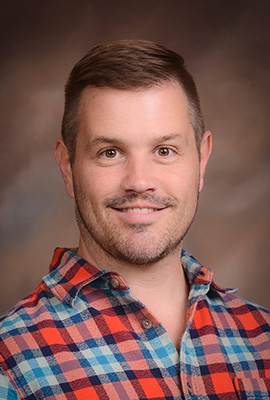Texas Woman's professor researches the cognitive side of dancing

Dance is often thought of as a form of emotional expression or as a recreational or fitness pursuit. But can dancing be thought of as a sign of intelligence?
It’s a notion that Assistant Professor Matthew Henley, MFA, PhD (dance) is researching in order to advocate for the value of dance in schools and question the common perception that intelligence only manifests through the use of abstract symbols like letters and numbers.
“I define intelligence as the ability to anticipate, simulate, and evaluate multiple options in order to achieve a goal,” says Henley, noting the influence of earlier scientists that looked at cognitive theory and multiple intelligences. “There’s a task that needs to be accomplished, and the cognitive efficiency with which you accomplish that task stands as a measure of your intelligence.”
The current environment in schools, Henley believes, reinforces traditional conceptions of intelligence by focusing on standardized testing. Although schools do incorporate physical activity into the school day, this activity is thought of as unrelated to a child’s academic achievement. In this climate, says Henley, “It becomes very difficult to advocate for the role of dance as part of the broader intellectual life of students. Dance educators and advocates need to better articulate the ways in which dance is part of the cognitive life of the student.”
Many people outside the dance classroom can’t imagine what cognitive processes happen while dancing. They tend to think that dancers simply imitate… the teacher dances, then the dancer’s body imitates the teachers model. There is a process of translation, however, between seeing and doing, which Henley believes is indicative of cognitive ability called fluid reasoning.
Although much of Henley’s work integrates embodied psychology and grounded cognition, the ability to describe how doing something physical – something very specific, like a dance phrase – provides the mind with the experience to generate abstract relationships was a difficult proposition to relate to others.
From this challenge, the basis for Henley’s research project began to develop. Relying on his background in Learning Sciences he hopes to advocate for the diversity of ways in which intelligence manifests. “Different people have different facilities or aptitudes with different types of symbol systems or sensory data,” he says. “You can imagine that a chef is particularly intelligent with the gustatory sense, and a perfumer is particularly intelligent with the olfactory sense, or perhaps a painter is particularly good with the visual sense… and dancers are particularly good with the kinesthetic and proprioceptive senses.”
Henley saw an opportunity with the opening of the Woodcock Institute at TWU, which supports neurocognitive research and applied practice. Although his research is quite different than what the Institute might normally fund, Henley saw an opportunity to work with them, receiving a research grant in 2016. “What I really appreciate about aligning with the Woodcock Institute is engaging with a framework called Cattell-Horn-Carroll theory, which is a description of cognitive abilities. This framework, which is not commonly used in dance education, provided me with language and concepts to create a bridge between our practice in the dance classroom and the ways in which cognitive abilities are described in the intellectual assessment community.”
In the first phase of his research, Henley adopted a general qualitative approach by analyzing the activity of students in a dance class, asking: How do these different cognitive abilities in Cattell-Horn-Carroll theory manifest in a dance classroom? How are the students using short term memory? How are they using long term memory? How are they using fluid reasoning in the dance classroom?
What’s emerged so far, through qualitative coding, analysis, and thick description, is a model for the ways in which dancers come to learn abstract concepts, or sets of abstract relationships, through the execution of physical actions.
He is now moving into a second phase of the research that focuses on the phenomenological experiences of the dancers. He hopes to gather further qualitative data from interviewing both teachers and students. His future plans include broadening the scope of his research to explore his ideas outside of the scope of dance.
Page last updated 11:44 AM, May 16, 2018